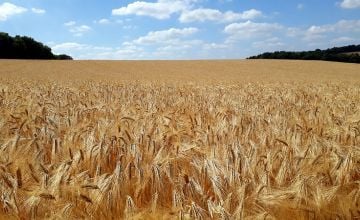
Read our 2024 annual report

Knowledge Hub
Right now millions of people in East Africa are on the brink of starvation, increasing numbers of people in Ireland are turning to food banks and food prices are at an all-time high. We’ve heard that the conflict in Ukraine is in part to blame so, just where does our food come from?
Farming
Around the world there are more than 608 million family farms, and the Food and Agriculture Organization of the UN (FAO) estimate that they produce around 80 per cent of the world’s food in value terms. This shows just how much globally we rely on family run farms for our essential food supplies. In many countries farming is not only a livelihood, but an essential source of food for communities too.

Where do we get our food from in Ireland?
Imported food means that here in Ireland we can pop to a supermarket or go online and buy almost any ingredient imaginable. In 2020, Ireland imported €9 billion worth of food and beverages it consumed but while we import a lot, we are also able to grow a lot; Ireland is largely self-sufficient in production of grains. But what happens if your country imports the essentials that you rely on to feed your family?

The effect of the Ukraine crisis on food production
Ukraine and the Russian Federation provide around 30 per cent of the world’s wheat and barley, one fifth of its maize, and over half of its sunflower oil. According to the United Nations Conference on Trade and Development, Africa imported about 85 per cent of its food from 2016-18 and we know that countries in East Africa import up to 90 per cent of their wheat from Ukraine and Russia. The ongoing conflict in Ukraine has meant blockades on Ukraine’s grain exports and created a surge in food prices with Kenya, Ethiopia, Somalia, Sudan and South Sudan likely to be the hardest hit by the fall-out of the ongoing conflict.
The role of climate in the East Africa hunger crisis
In addition to the conflict in Ukraine, East Africa is suffering from four consecutive failed rainy seasons, with an expected fifth to come, and is experiencing its worst drought in four decades- a climate shock exacerbated by the ongoing conflict above. More than 23 million people are acutely food insecure across Ethiopia, Kenya, Somalia and South Sudan with this figure likely to rise to 27 million by September. Most people in the region are reliant on the land and their animals to survive and the drought is destroying their livelihoods. Millions of people are leaving their homes and villages to find food, water and pasture. In the most desperate situations, families are selling their livestock to afford food for their children.
Taking desperate measures and watching helplessly as your children starve is the devastating reality for many parents and the result of a situation compounded by conflict, locusts and Covid-19.
The number of people facing extreme hunger is growing every day. There is no time to lose.

Facts about food production around the world
- China is the world’s biggest producer, importer, and consumer of food.
- There are more than 50,000 edible plants in the world, but just 15 of them provide 90 percent of the world’s food energy intake. Rice, maize and wheat make up two-thirds of this.
- Rice is a food staple for more than 3.5 billion people around the world.
- Nearly a third of all food (1.3 billion tons) produced each year is wasted or lost before it can be consumed; in many high-income countries this is wasted by allowing food to go off, or having uneaten leftovers, but in lower-income countries food waste happens at harvest time. Poor storage facilities may lead to pest infestations or mould, or sometimes farmers simply don’t have the labour or financial resources to harvest crops.
- Consumers in rich countries waste almost as much food as the entire net food production of sub-Saharan Africa each year.

